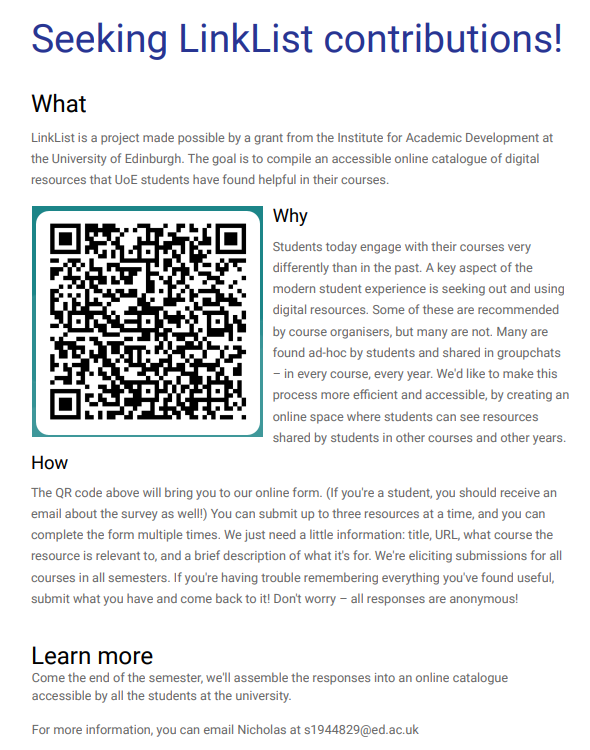
This post tells the story of LinkList, an IAD-funded Student-Staff Partnership Project undertaken by Cinzia Pusceddu and Nicholas Daines this past semester. The post was written by Cinzia who is an education professional at The University of Edinburgh. It belongs to the Hot topic series: Student Partnership Agreement 2023↗️.
The purpose of this project was to conduct a survey aimed at understanding the non-university resources that students utilise in their courses. The goal was to collect resource links and insights to enhance student learning experiences.
Through anecdotal evidence and conversations, we learned that students often rely on useful non-university resources to complement their coursework, and often share them with their coursemates. We figured that this helpful practice was worth exploring – wouldn’t it be better if students could benefit from previous students’ resources? Better yet, if students could browse the courses of their peers and see what sort of things they’re using? To that end, we wanted to construct a curated list of student-submitted resources.
To achieve our goal we created a student survey. We designed and distributed a survey to students in Engineering (we had hoped to conduct the survey across multiple Schools, but a delay with permission from the Ethics Committee forced us to limit it to the School of Engineering). The survey included questions about the non-university resources they used, the reasons for their choices, and the benefits they derived from these resources. The survey was distributed through university communication channels and social media platforms. We even circulated the survey by hanging posters with descriptions and QR codes in the university library around finals revision time when we figured many students would be in.
With the first round of collecting results, we only got one response, which indicated the resource ‘Probability course’ to calculate probability. We were quite surprised by such a low response and thought that perhaps the survey’s initial wording and question flow may have put students off. For example, we had put questions about course information before the question that simply asked for the link to the online resource. That may have made the survey seem like a hassle that students simply didn’t want to bother with. Therefore, we made the survey design simpler, just asking for a link and a little description, with all other information being optional. We had the link sent out again.

The second time around we had a slightly higher uptake – technically. We got seven responses. Two of them were irrelevant (reference to SharkTank video and Fullycharged show). Two indicated collaborative tools like Miro and Mural; one mentioned Harvard Business Review, whilst another listed the site Duckster which supports history for kids (perhaps a joke?), and the last one mentionned ChatGPT. These findings, though limited in number, seem to suggest that students rely on non-institutional digital material and tools to supplement their learning experiences. The willingness of some respondents to contribute additional resources indicates the potential for future engagement and data collection efforts to yield more comprehensive insights.
The project faced a few challenges, but the main one was the low number of survey responses. Despite a more straightforward survey design in the second round, survey participation remained limited. The reasons for this low engagement are not entirely clear to us. We conducted the ‘Curriculum Renewal Student Input Survey’ last summer in the School of Engineering, and it was rather successful (nearly 100 responses within the same time frame). Therefore, we expected a similar amount of uptake, at least the second time around when we were more confident with our survey’s design. Especially so when considering that the Curriculum Renewal survey was sent out in the middle of the summer break when almost all students were away and not engaged in study, whereas this survey was sent out at a time when students were quite actively engaged with their studies. Upon reflection, we expect that the crucial difference between the current survey and last year’s survey is that the Curriculum Renewal survey gave students an opportunity to voice their thoughts about those elements of their classes that they did not enjoy and would like to see changed, whereas this one did not. For that reason, completing this survey may simply have been of less interest to students. Perhaps offering incentives, such as gift cards or access to exclusive resources, could have helped motivate student participation.
Another possible reason for the low uptake could be that our survey was limited to the School of Engineering. Through conversations with Engineering and non-Engineering students, it became anecdotally clear that the learning materials used in Engineering disciplines may be less conducive to our goal as in, e.g., social science fields.
This project was not a success. However, we see it as a bit like an unripen fruit with great potential. In fact, the project’s small dataset offers a glimpse into the potential value of online platforms for supplementary materials in student learning. The limited data suggested that students might turn to these online resources for additional support. The challenges encountered underscore the need for a strategic approach in the future to increase survey participation. For instance, extend the survey to all Schools; explore the possibility of offering incentives to motivate student participation; consider extending the survey period to encourage a higher number of responses; complement survey data with qualitative insights from interviews or focus groups with students. This can provide a deeper understanding of resource preferences and experiences.
In conclusion, while LinkList did not meet its intended objectives, it was, for us, a valuable learning experience. The lesson we learned is that a more strategic approach can lead to different outcomes in understanding how students use external resources to support their studies. Despite its shortcomings, the project lays the foundation for further research aimed at enhancing student learning experiences through such resources. The dream lives on!
Cinzia Pusceddu
Meet Cinzia, a curious mind with a passion for knowledge and communication. An education professional since 2001, Cinzia has always been fascinated by the impact of technology on the way we learn and live, dedicating her work to exploring this through innovative teaching, international research in digital humanities and digital education, and the creation of educational projects. Recently recognized with the Senior Fellowship by Advance HE, she is now enthusiastically delving into the potential of generative AI in education.


